2019 KIA OPTIMA HYBRID ABS
[x] Cancel search: ABSPage 511 of 553
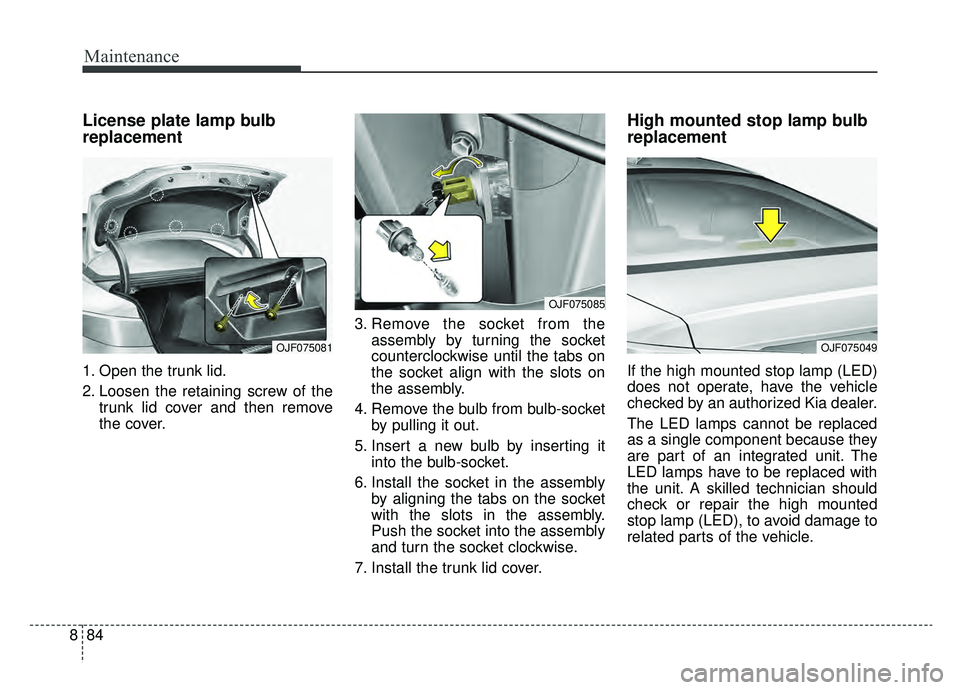
Maintenance
84
8
License plate lamp bulb
replacement
1. Open the trunk lid.
2. Loosen the retaining screw of the
trunk lid cover and then remove
the cover. 3. Remove the socket from the
assembly by turning the socket
counterclockwise until the tabs on
the socket align with the slots on
the assembly.
4. Remove the bulb from bulb-socket by pulling it out.
5. Insert a new bulb by inserting it into the bulb-socket.
6. Install the socket in the assembly by aligning the tabs on the socket
with the slots in the assembly.
Push the socket into the assembly
and turn the socket clockwise.
7. Install the trunk lid cover.
High mounted stop lamp bulb
replacement
If the high mounted stop lamp (LED)
does not operate, have the vehicle
checked by an authorized Kia dealer.
The LED lamps cannot be replaced
as a single component because they
are part of an integrated unit. The
LED lamps have to be replaced with
the unit. A skilled technician should
check or repair the high mounted
stop lamp (LED), to avoid damage to
related parts of the vehicle.
OJF075081
OJF075085
OJF075049
Page 513 of 553
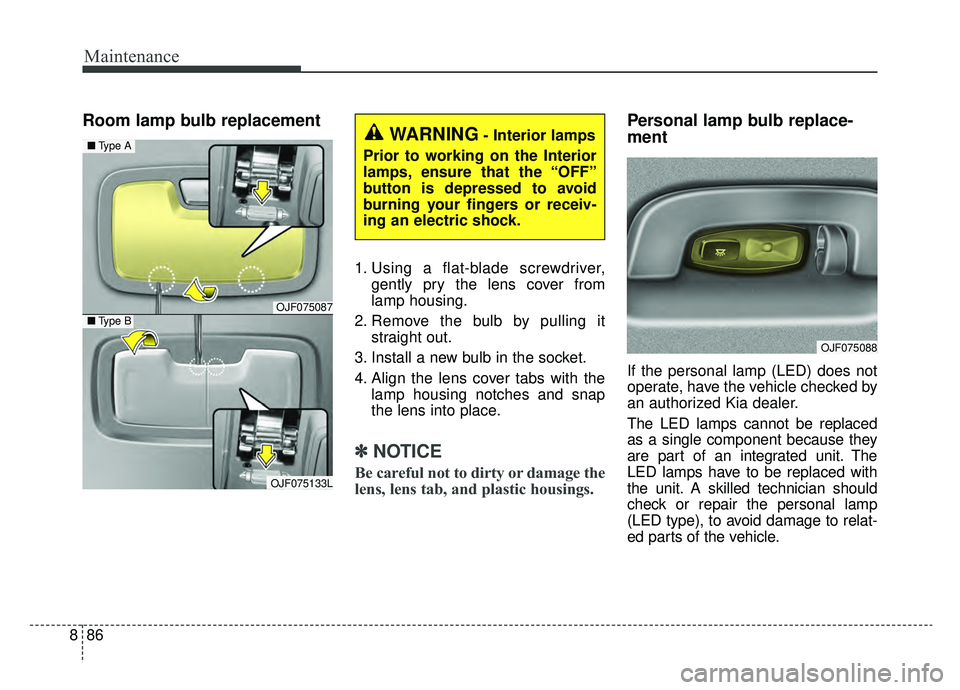
Maintenance
86
8
Room lamp bulb replacement
1. Using a flat-blade screwdriver,
gently pry the lens cover from
lamp housing.
2. Remove the bulb by pulling it straight out.
3. Install a new bulb in the socket.
4. Align the lens cover tabs with the lamp housing notches and snap
the lens into place.
✽ ✽NOTICE
Be careful not to dirty or damage the
lens, lens tab, and plastic housings.
Personal lamp bulb replace-
ment
If the personal lamp (LED) does not
operate, have the vehicle checked by
an authorized Kia dealer.
The LED lamps cannot be replaced
as a single component because they
are part of an integrated unit. The
LED lamps have to be replaced with
the unit. A skilled technician should
check or repair the personal lamp
(LED type), to avoid damage to relat-
ed parts of the vehicle.
OJF075087
OJF075133L
■ Type A
■Type B
WARNING- Interior lamps
Prior to working on the Interior
lamps, ensure that the “OFF”
button is depressed to avoid
burning your fingers or receiv-
ing an electric shock.
OJF075088
Page 521 of 553
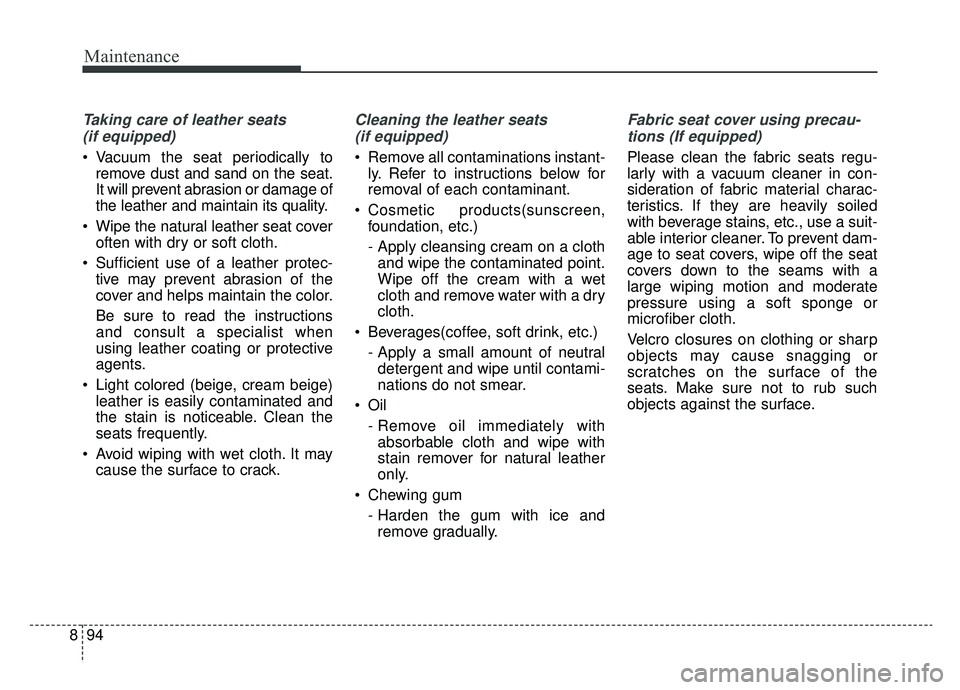
Maintenance
94
8
Taking care of leather seats
(if equipped)
Vacuum the seat periodically to remove dust and sand on the seat.
It will prevent abrasion or damage of
the leather and maintain its quality.
Wipe the natural leather seat cover often with dry or soft cloth.
Sufficient use of a leather protec- tive may prevent abrasion of the
cover and helps maintain the color.
Be sure to read the instructions
and consult a specialist when
using leather coating or protective
agents.
Light colored (beige, cream beige) leather is easily contaminated and
the stain is noticeable. Clean the
seats frequently.
Avoid wiping with wet cloth. It may cause the surface to crack.
Cleaning the leather seats
(if equipped)
Remove all contaminations instant- ly. Refer to instructions below for
removal of each contaminant.
Cosmetic products(sunscreen, foundation, etc.)
- Apply cleansing cream on a clothand wipe the contaminated point.
Wipe off the cream with a wet
cloth and remove water with a dry
cloth.
Beverages(coffee, soft drink, etc.) - Apply a small amount of neutraldetergent and wipe until contami-
nations do not smear.
Oil - Remove oil immediately withabsorbable cloth and wipe with
stain remover for natural leather
only.
Chewing gum - Harden the gum with ice andremove gradually.
Fabric seat cover using precau-
tions (If equipped)
Please clean the fabric seats regu-
larly with a vacuum cleaner in con-
sideration of fabric material charac-
teristics. If they are heavily soiled
with beverage stains, etc., use a suit-
able interior cleaner. To prevent dam-
age to seat covers, wipe off the seat
covers down to the seams with a
large wiping motion and moderate
pressure using a soft sponge or
microfiber cloth.
Velcro closures on clothing or sharp
objects may cause snagging or
scratches on the surface of the
seats. Make sure not to rub such
objects against the surface.
Page 524 of 553
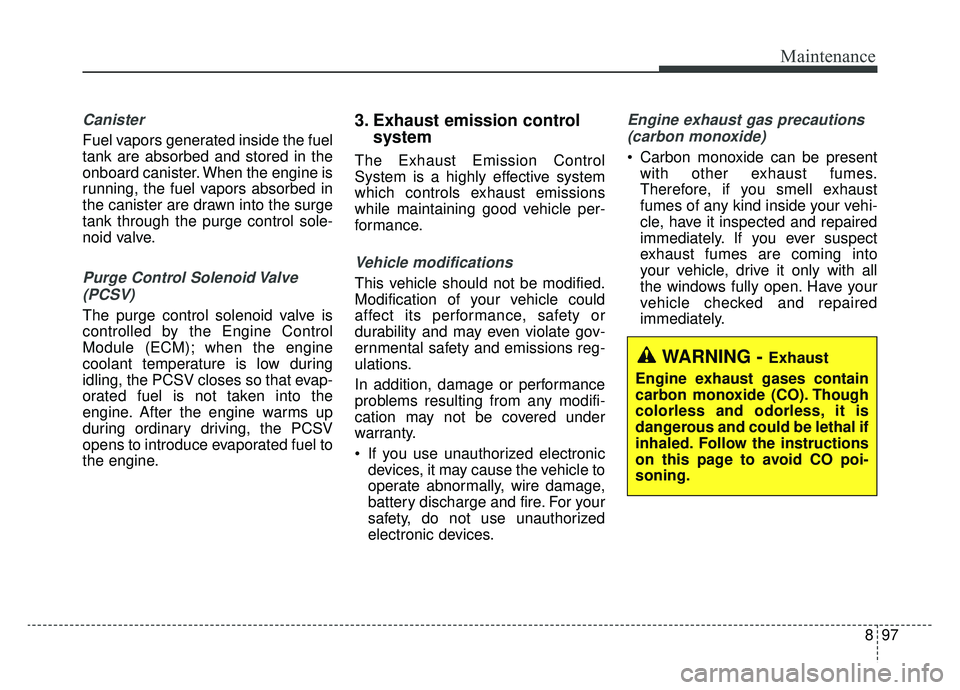
897
Maintenance
Canister
Fuel vapors generated inside the fuel
tank are absorbed and stored in the
onboard canister. When the engine is
running, the fuel vapors absorbed in
the canister are drawn into the surge
tank through the purge control sole-
noid valve.
Purge Control Solenoid Valve(PCSV)
The purge control solenoid valve is
controlled by the Engine Control
Module (ECM); when the engine
coolant temperature is low during
idling, the PCSV closes so that evap-
orated fuel is not taken into the
engine. After the engine warms up
during ordinary driving, the PCSV
opens to introduce evaporated fuel to
the engine.
3. Exhaust emission control system
The Exhaust Emission Control
System is a highly effective system
which controls exhaust emissions
while maintaining good vehicle per-
formance.
Vehicle modifications
This vehicle should not be modified.
Modification of your vehicle could
affect its performance, safety or
durability and may even violate gov-
ernmental safety and emissions reg-
ulations.
In addition, damage or performance
problems resulting from any modifi-
cation may not be covered under
warranty.
If you use unauthorized electronic
devices, it may cause the vehicle to
operate abnormally, wire damage,
battery discharge and fire. For your
safety, do not use unauthorized
electronic devices.
Engine exhaust gas precautions
(carbon monoxide)
Carbon monoxide can be present with other exhaust fumes.
Therefore, if you smell exhaust
fumes of any kind inside your vehi-
cle, have it inspected and repaired
immediately. If you ever suspect
exhaust fumes are coming into
your vehicle, drive it only with all
the windows fully open. Have your
vehicle checked and repaired
immediately.
WARNING - Exhaust
Engine exhaust gases contain
carbon monoxide (CO). Though
colorless and odorless, it is
dangerous and could be lethal if
inhaled. Follow the instructions
on this page to avoid CO poi-
soning.
Page 544 of 553
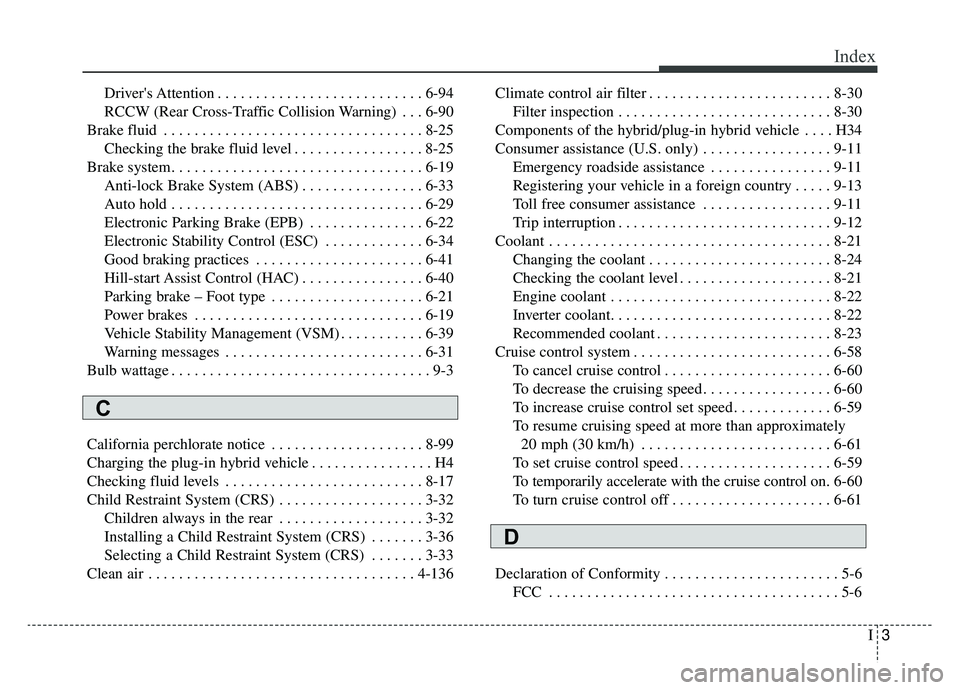
I3
Index
Driver's Attention . . . . . . . . . . . . . . . . . . . . . . . . . . . 6-94
RCCW (Rear Cross-Traffic Collision Warning) . . . 6-90
Brake fluid . . . . . . . . . . . . . . . . . . . . . . . . . . . . . . . . . . 8-25\
Checking the brake fluid level . . . . . . . . . . . . . . . . . 8-25
Brake system. . . . . . . . . . . . . . . . . . . . . . . . . . . . . . . . . 6-19 Anti-lock Brake System (ABS) . . . . . . . . . . . . . . . . 6-33
Auto hold . . . . . . . . . . . . . . . . . . . . . . . . . . . . . . . . . 6-29
Electronic Parking Brake (EPB) . . . . . . . . . . . . . . . 6-22
Electronic Stability Control (ESC) . . . . . . . . . . . . . 6-34
Good braking practices . . . . . . . . . . . . . . . . . . . . . . 6-41
Hill-start Assist Control (HAC) . . . . . . . . . . . . . . . . 6-40
Parking brake – Foot type . . . . . . . . . . . . . . . . . . . . 6-21
Power brakes . . . . . . . . . . . . . . . . . . . . . . . . . . . . . . 6-19
Vehicle Stability Management (VSM) . . . . . . . . . . . 6-39
Warning messages . . . . . . . . . . . . . . . . . . . . . . . . . . 6-31
Bulb wattage . . . . . . . . . . . . . . . . . . . . . . . . . . . . . . . . . . 9-3
California perchlorate notice . . . . . . . . . . . . . . . . . . . . 8-99
Charging the plug-in hybrid vehicle . . . . . . . . . . . . . . . . H4
Checking fluid levels . . . . . . . . . . . . . . . . . . . . . . . . . . 8-17
Child Restraint System (CRS) . . . . . . . . . . . . . . . . . . . 3-32 Children always in the rear . . . . . . . . . . . . . . . . . . . 3-32
Installing a Child Restraint System (CRS) . . . . . . . 3-36
Selecting a Child Restraint System (CRS) . . . . . . . 3-33
Clean air . . . . . . . . . . . . . . . . . . . . . . . . . . . . . . . . . . . 4-\
136 Climate control air filter . . . . . . . . . . . . . . . . . . . . . . . . 8-30
Filter inspection . . . . . . . . . . . . . . . . . . . . . . . . . . . . 8-30
Components of the hybrid/plug-in hybrid vehicle . . . . H34
Consumer assistance (U.S. only) . . . . . . . . . . . . . . . . . 9-11 Emergency roadside assistance . . . . . . . . . . . . . . . . 9-11
Registering your vehicle in a foreign country . . . . . 9-13
Toll free consumer assistance . . . . . . . . . . . . . . . . . 9-11
Trip interruption . . . . . . . . . . . . . . . . . . . . . . . . . . . . 9-12
Coolant . . . . . . . . . . . . . . . . . . . . . . . . . . . . . . . . . . . . \
. 8-21 Changing the coolant . . . . . . . . . . . . . . . . . . . . . . . . 8-24
Checking the coolant level . . . . . . . . . . . . . . . . . . . . 8-21
Engine coolant . . . . . . . . . . . . . . . . . . . . . . . . . . . . . 8-22
Inverter coolant. . . . . . . . . . . . . . . . . . . . . . . . . . . . . 8-22
Recommended coolant . . . . . . . . . . . . . . . . . . . . . . . 8-23
Cruise control system . . . . . . . . . . . . . . . . . . . . . . . . . . 6-58 To cancel cruise control . . . . . . . . . . . . . . . . . . . . . . 6-60
To decrease the cruising speed . . . . . . . . . . . . . . . . . 6-60
To increase cruise control set speed . . . . . . . . . . . . . 6-59
To resume cruising speed at more than approximately 20 mph (30 km/h) . . . . . . . . . . . . . . . . . . . . . . . . . 6-61
To set cruise control speed . . . . . . . . . . . . . . . . . . . . 6-59
To temporarily accelerate with the cruise control on . 6-60
To turn cruise control off . . . . . . . . . . . . . . . . . . . . . 6-61
Declaration of Conformity . . . . . . . . . . . . . . . . . . . . . . . 5-6 FCC . . . . . . . . . . . . . . . . . . . . . . . . . . . . . . . . . . . . \
. . 5-6
C
D